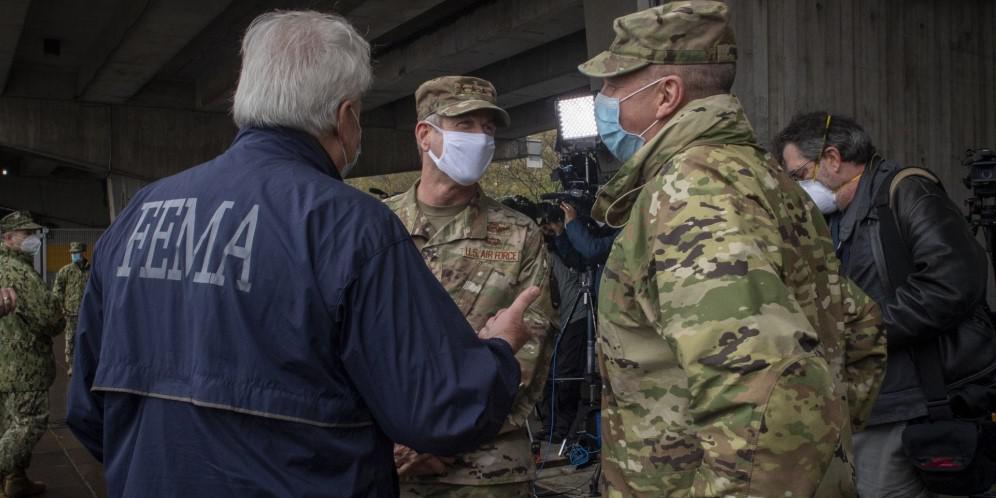Specialized Teams Could Lift Combatant Commands' Use of AI
The 11 combatant commands of the U.S. military are on the front lines of protecting U.S. national security. They hold the toughest problem sets, from protecting and defending the United States or its interests abroad, deterring aggression, carrying out missions, providing humanitarian assistance or building cooperation with other nations.
More and more, the commands face a complex operating environment, one in which information and decision advantage are key to their success. Already, some commands, such as the Northern Command (NORTHCOM) and the North American Aerospace Defense Command (NORAD) are leveraging artificial intelligence and decision aids to support operations. The National Security Commission on Artificial Intelligence, or NSCAI, recommends that all commands broaden their use of artificial intelligence (AI) and machine learning and should do so by setting up specialized teams at each command.
NSCAI recently released a comprehensive 760-page report on how the Defense Department can provide the resources, processes and organizations to enable the integration of AI at a much greater scale into the military and the federal government. Given the immense threat from China’s move to harness artificial intelligence, the Defense Department must advance its capabilities quickly.
“We are not organized to win this competition [against China],” said Robert Work, vice chair of NSCAI. “By 2025, DOD and the federal government should have the pieces in place for widespread integration of artificial intelligence.”
NORTHCOM and NORAD tested three decision aids—Cosmos, Lattice and Gaia—during its recent Global Information Dominance Experiment 2, or GIDE 2. The AI tools rapidly brought information to commanders as they conducted a world-scale scenario against two near-peer adversaries. Gen. Glen Vanherck, USAF, leader of the two commands, saw firsthand how the tools gave the commands the ability to collaborate with all of the combatant commands in near real-time across all domains. And he is calling for the Defense Department to meet the commands’ demand signal to add more artificial intelligence and machine learning capabilities.
In turn, the NSCAI advises the U.S. combatant commands to stand up AI-delivery teams to have a dedicated group that would develop and deploy AI applications to support operational units, explained Tara Rigler, director for Strategy, Communications and Engagements at NSCAI.
Ideally, the specialized teams would include data scientists, artificial intelligence modelers and testers, software engineers, product managers and other experts across the full development stack, Rigler said. “[They] should be staffed with the appropriate talent to manage the full life cycle of AI solutions,” she stated.
The specialized AI teams would be responsible for finding, tailoring and fielding AI applications from the digital ecosystem, including levering algorithms or tools developed by the other combatant commands, the DOD software factories or directly from the Joint Artificial Intelligence Center (JAIC), the NSCAI director explained. The teams would create additional sustainable mission applications as needed, as well as contribute AI applications to the greater ecosystem for use across the commands to meet their common challenges.
“Each combatant commander should also develop and implement a plan for the integration of forward-deployed development teams to act as the local customer interface for the AI delivery teams and operational units,” Rigler indicated. “These teams would work side-by-side with warfighters to identify operational use cases for AI-enabled applications. They would also leverage the digital ecosystem to provision development environments and tools to produce ‘quick wins’ to improve effectiveness and generate efficiencies.”
Lt. Gen. Michael Groen, USMC, director of JAIC, emphasized that the commands are a crucial customer for AI and may help to drive its greater use. “The combatant commands, especially the commanders, have caught a glimpse of what the future might look like through a series of integrative exercises,” Gen. Groen said. “They like it, and they are eager to gain these capabilities. And we pay keen attention to the demand signals from the combatant commands, and we want to work with anybody who is doing AI today across DOD.”
In addition, the elevation of JAIC to be under the authority of the deputy secretary of defense—which was included in the latest National Defense Department Authorization bill—also helps in the quest to add considerable AI capabilities, he continued. “With the JAIC now aligned under the deputy secretary, it gives her and the rest of the department leadership access to the tools and processes to reinforce their AI priorities.”
Moreover, Congress also granted the center the ability to exercise some limited acquisition authority on a trial basis. “Because of our congressional authority now to do our own acquisition, for example, we can now actually start providing a much broader array of support services and enabling services that help make all of those customers successful,” the general said.
“I'm happy to report as the director of the JAIC some positive momentum toward implementation of AI at scale,” he noted. “We certainly have a long way to go, but you can see the needle trending positive with bipartisan support from Congress and with great support from the DOD leadership.”
“You have to accelerate and scale technology adoption,” Work noted. “You really have to push this. [By] standing up an AI development team at every single COCOM [combatant command] with forward deployable elements, they would leverage the technological knowledge to develop innovative operational concepts and essentially establish a pull for AI-enabled applications that will help them accomplish their missions.”
Rigler provided follow-up information to SIGNAL Magazine about the AI teams following a recent press conference at the Pentagon with Work and Gen. Groen.





Comments